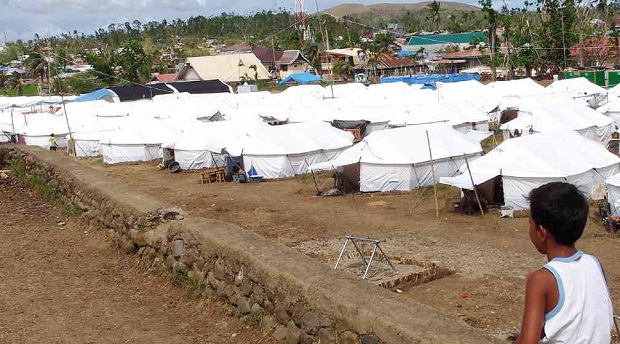
ABOUT 2,000 residents of Estancia town, Iloilo province, have been living in tents and classrooms at Northern Iloilo Polytechnic State College for nearly a month after they were evacuated from Barangay Botongon due to a typhoon-triggered oil spill. NESTOR P. BURGOS JR./INQUIRER VISAYAS
ESTANCIA, Iloilo—Ester Bacanto, 14, is looking forward to going home today after her village was declared free of toxic fumes from an oil spill induced by Supertyphoon “Yolanda.”
She does not mind if their house is in shambles and supported only by bamboo poles.
“It’s difficult here. There are so many people and you cannot move freely,” she said inside a tent at Northern Iloilo Polytechnic State College West Campus.
Bacanto’s family is among 497 families, or more than 2,000 people, who have been staying on the campus since Nov. 23 after they evacuated from Barangay Botongon, which has been severely contaminated by the oil spill.
The evacuees stay in 36 classrooms and 137 tents donated by private groups and relief organizations. They have depended on food assistance from the government and private relief organizations.
Health and local officials had ordered the mandatory transfer of residents within a 150-meter radius from the oil spill site after tests showed that the level of toxic substance benzene in the air was 15 times higher than the tolerable level.
Strong winds and huge waves brought by Yolanda slammed the 32-megawatt Power Barge 103 operated by National Power Corp. onto the rocky shores of Botongon, triggering an oil spill on Nov. 8.
Estimates of the volume of bunker fuel spilled into the coastline ranged from 200,000 to 900,000 liters.
On Thursday, Iloilo Gov. Arthur Defensor Sr. announced that the evacuees could return to their village after the Department of Health (DOH) released test results showing that the presence of benzene, a colorless but highly flammable chemical found in gasoline, in most of the village was gone.
Dr. Marlyn Convocar, DOH regional director, said the tests, jointly conducted by the DOH and the Environmental Management Bureau of the Department of Environment and Natural Resources (DENR), showed that the benzene level was zero parts per million (ppm) below the tolerable level of 0.5 ppm.
However, access within a 20-meter radius from the site would be restricted and continued monitoring of air quality would be conducted, Convocar said.
The cleanup of the contaminated coastline and water and the removal of the barge could take at least several weeks, according to Karl Ignatius Young, president of Kuan Yu Global Technologies Inc. The firm has been contracted by the government to clean up the spill.
Convocar said workers involved in the operations would be allowed to work only if they wear the prescribed protective equipment.
Bayan Muna Rep. Neri Colmenares, who was in Estancia to distribute relief assistance to typhoon victims, said the party-list group would support an independent evaluation of air and water quality in the oil-spill-affected areas.
A team from the nongovernment Center for Environmental Concerns will conduct its own test to validate the DOH-DENR findings, Colmenares said.
“Even if the findings are correct, the government must continue assisting the residents because they were forced to leave their houses because of the oil spill,” he said.
Although they were allowed to return home, some evacuees are hesitant to leave their temporary shelter.
“Even if the air is safe, where will we live?” Regine Biana said. She said her house was destroyed and most of their belongings were lost.
Biana, 21, said each family would receive P300 for transportation to transfer their belongings back to their house, but she said this was not enough.
“We are hoping that the government will extend financial assistance to help us rebuild our houses. But we do not know when that will come,” she said.
Jerry Bionat, executive officer of the provincial disaster risk reduction and management office, said residents who choose to remain in the evacuation center would stay in tents because the classrooms had to be evacuated when the school reopens in January.
Social Welfare Secretary Dinky Soliman, who was in Estancia on Dec. 4 along with Interior Secretary Mar Roxas and Defense Secretary Voltaire Gazmin, had assured the evacuees that each family would receive food assistance for the whole of December in three batches, with each batch containing 25 kilos of rice, canned goods and noodles.
But Biana said it had been a week since she received rice assistance.